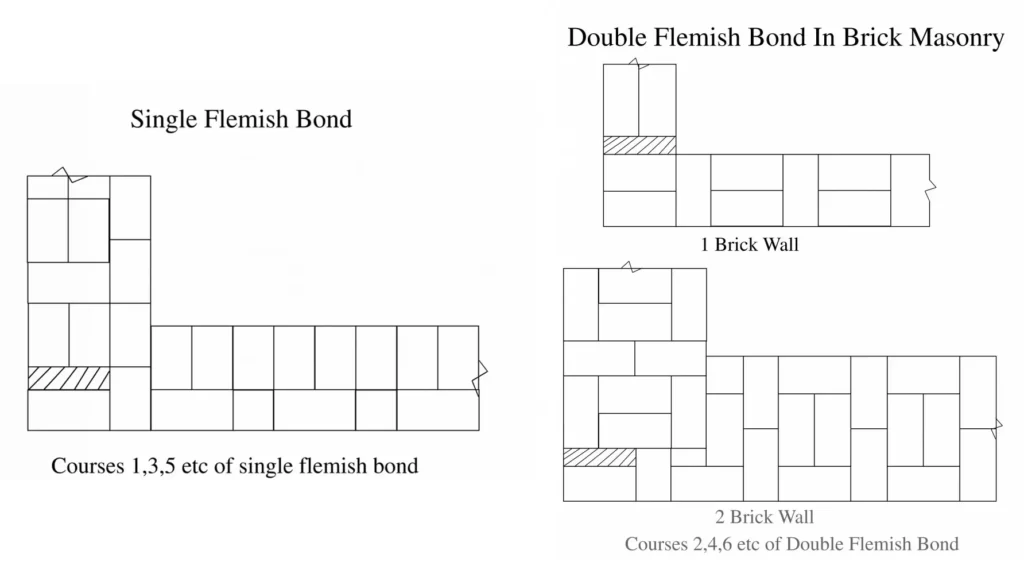If you want to know about the types of bonds in brick masonry or brick masonry or concrete mix design, please click the link.
In brick masonry, a bond refers to the pattern in which bricks are laid in relation to each other. There are several different types of bonds that can be used in brick masonry, including:

- Stretcher Bond: This is the most basic bond, in which bricks are laid with their long faces (stretchers) parallel to the face of the wall.
- Header Bond: In this bond, bricks are laid with their short faces (headers) parallel to the face of the wall.
- English Bond: This bond alternates courses of stretcher and header bricks.
- Flemish Bond: This bond alternates headers and stretchers within each course.
- Running Bond: This bond is similar to stretcher bond but with every fifth course shifted half a brick.
- Stack Bond: This bond is similar to stretcher bond but with no horizontal joint between the bricks. This bond is not commonly used due to its lack of strength and stability.
- Rowlock Bond: In this bond, bricks are laid with their long faces vertical and their short faces horizontal. This bond is commonly used for walls with a curved shape.
- Jack Bond: This bond is similar to Flemish bond, but with the headers shifted half a brick to one side. This bond is used for decorative purposes and is not recommended for load-bearing walls.
- Herringbone Bond: This bond is formed by laying bricks at a 45-degree angle in a zig-zag pattern. This bond is not commonly used and is considered to be a decorative pattern.
- Rat-trap Bond: This bond is a variation of Flemish bond, but with a “rat-trap” course of headers sandwiched between two courses of stretchers. This bond gives a decorative finish and is used for structural walls
Each bond has its own unique appearance and requires different skills to construct. The choice of bond will depend on the architectural design, structural requirements and the skill of the mason.
1) Difference Between English Bond And Flemish Bond
English Bond and Flemish Bond are both types of brickwork patterns used in masonry construction.

| English Bond | Flemish Bond | |
| 1. | English Bond has more strength than the Flemish bond. | Flemish Bond does not have more strength than the English bond. |
| 2. | English Bond does not have a more pleasing appearance. | Flemish Bond does have a more pleasing appearance. |
| 3. | The construction of an English bond does not require any great skill. | Construction of the Flemish bond required additional skill. |
| 4. | We do not use broken bricks in English bonds. | We do use broken bricks in Flemish Bond. |
| 5. | Alternate courses consist of stretchers and headers. | In every course, the headers and stretchers are placed alternatively. |
In summary, English bond is strong and durable pattern, mostly used on load bearing walls, while Flemish bond is decorative pattern with alternating courses of headers and stretchers in each row.
2) Difference Between English Bond and Dutch Bond
The main difference between an English bond and a Dutch bond is the way the bricks are laid in the wall. In an English bond, the bricks are laid with one stretcher (the long side of the brick) facing out in each course, alternating with a header (the short side of the brick) in the next course.
This creates a pattern of long and short sides that is visually appealing and strong. In a Dutch bond, the bricks are laid with alternating headers and stretchers in each course, creating a more random pattern. This bond is considered stronger than the English bond.

| English Bond | Dutch Bond | |
| 1. | English Bond is not a modified bond. | Dutch bond is a modified form of the English bond. |
| 2. | Alternate courses consist of stretchers and headers. | Dutch Bond also consists of stretchers and headers in alternate courses. |
| 3. | English bond strengthened brickwork. | Dutch bond strengthened the corner of the wall. |
3) Difference Between English Bond and Stretcher Bond
English bond and stretcher bond are both types of bricklaying patterns used in masonry construction. The main difference between the two is the way the bricks are laid.

| English Bond | Stretcher Bond | |
| 1. | Alternate courses consist of stretchers and headers. | All the courses consist of only stretchers. |
| 2. | English bond is the strongest bond of brickwork. | Stretcher bond is a weak bond of brickwork. |
Also, English bond is more decorative than stretcher bond as it creates a more varied pattern.
4) Difference Between Single Flemish Bond and Double Flemish Bond
Single Flemish bond and double Flemish bond are both types of brickwork patterns used in masonry construction.

| Single Flemish Bond | Double Flemish Bond | |
| 1. | The single Flemish bond is a combination of English and Flemish bonds. | Each course presents the same appearance both in the back and the face of the wall. |
| 2. | In course, facing is Flemish and backing is English. | Every course consists of a header and stretchers alternatively. |
In summary, Single Flemish bond uses alternate courses of stretcher and headers bricks, while Double Flemish Bond uses additional header brick in center of each stretcher course, making the pattern more complex and stronger bond.